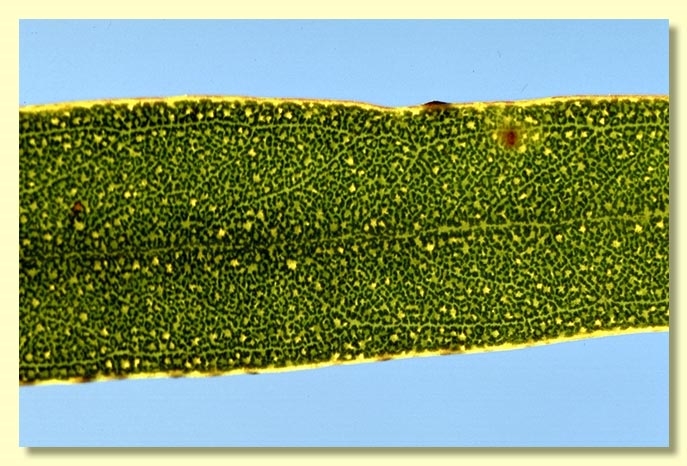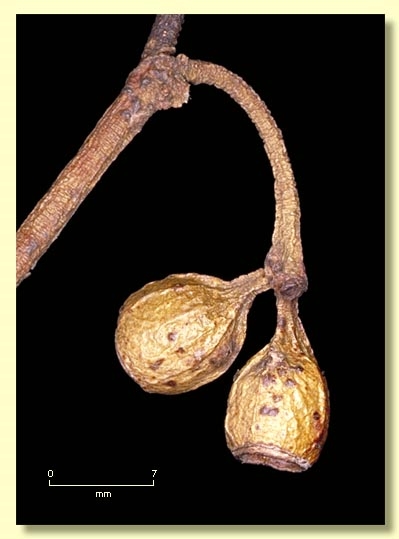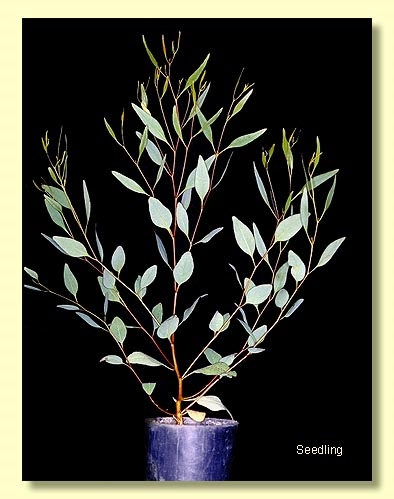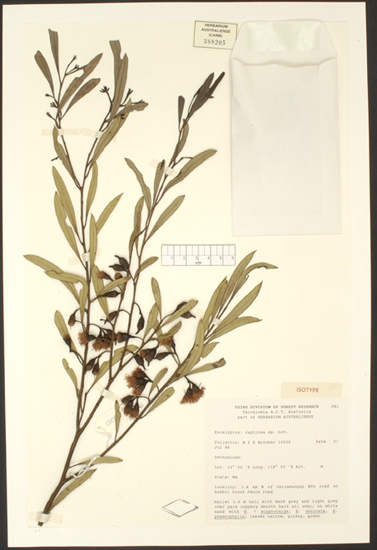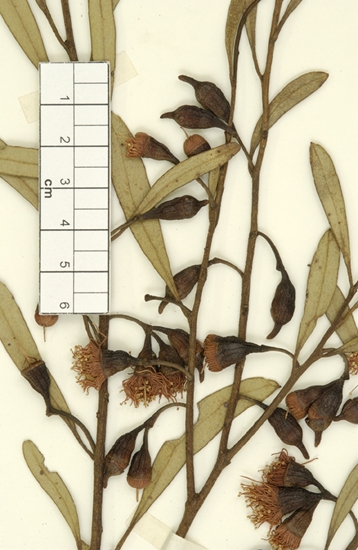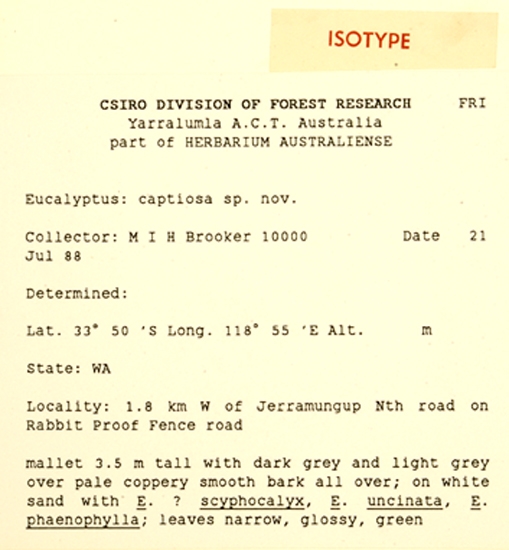Eucalyptus | Symphyomyrtus | Dumaria | Incrassatae
Euclid - Online edition
Eucalyptus captiosa
Whipstick mallee forming a ?lignotuber.
Bark on trunks partly rough with imperfectly shed grey-brown ribbons, or smooth throughout, dark and light grey over pale coppery or orange-brown.
Branchlets usually with oil glands in the pith but sometimes difficult to find.
Juvenile growth (coppice or field seedlings to 50 cm): stems rounded in cross-section; juvenile leaves always petiolate, opposite only at the lowest node then alternate, oblong to ovate or lanceolate, 6–12 cm long, 2–3.7 cm wide, marginal lenticels may be present, lowest leaves dull, blue-green, soon glossy, green.
Adult leaves thick, held erect, alternate, petioles 0.5–1.5 cm long; blade linear to narrowly elliptical, 4–8.8 cm long, 0.5–1.3 cm wide, base tapering to petiole, margin entire but lenticels sometimes present, apex acute or rounded and apiculate, concolorous, at least slightly glossy, green, side-veins at an acute or wider angle to midrib, reticulation moderate to dense, broken, intramarginal vein close to margin, oil glands few, intersectional.
Inflorescence axillary unbranched, peduncles widen slightly apically, 0.8–1.5 cm long, erect, spreading or pendulous, buds 3 or 7 per umbel, pedicels 0.2–0.6 cm long. Mature buds pyriform to obovoid (1.3–1.9 cm long, 0.5–0.7 cm wide), usually with longitudinal ribs, scar present, operculum beaked, rarely bluntly so (0.8–1.1 cm long), stamens inflexed, anthers cuboid to globular, versatile, sub-basifixed, dehiscing by longitudinal slits, style long and straight, stigma blunt or slightly tapered, locules 3(4), the placentae each with 4 vertical rows of ovules. Flowers cream to pale yellow.
Fruit pedicellate (pedicels 0.2–0.7(1) cm long), cylindrical to barrel-shaped or cupular, 0.8–1.5 cm long, 0.8–1.1 cm wide, slightly ribbed longitudinally or smooth, disc descending vertically, valves 3(4), usually just below rim level.
Seeds blackish or grey-brown, 1.5–3 mm long, flattened-ovoid to almost cuboid, usually with narrow marginal flange, dorsal surface shallowly reticulate, ventral surface ridged if seed tend to cuboid, hilum ventral or terminal.
Cultivated seedlings (measured at ca node 10): cotyledons reniform; stems rounded in cross-section; leaves always petiolate, opposite for 2 or 3 nodes then alternate, lanceolate or ovate, 5–6.5 cm long, 0.8–2.5 cm wide, margin may be irregular due to lenticels, dull, grey-green becoming glossy, green by ca node 10.
Flowering has been recorded in May, July, August, September, October and November.
A mallee endemic to Western Australia, occurring in the south from Tambellup to Jerramungup and particularly in the upper Gairdner River catchment. The bark is smooth, occasionally ribbony. The adult leaves are glossy, green and conspicuously narrow.
Eucalyptus captiosa belongs in Eucalyptus subgenus Symphyomyrtus section Dumaria because the buds have two opercula, stamens are strongly inflexed, ovules are in 4 rows on the placentae and cotyledons are reniform. E. incrassata, E. angulosa, E. captiosa, E. singularis and E. ceratocorys are closely related, forming series Incrassatae within this section Dumaria.
E. captiosa with its slender leaves and small buds with prominently beaked opercula, has a sub-coastal distribution in mallee heath on sands. E. angulosa is a mallee of coastal headlands and dunes, with very coarse leaves, buds and fruits. E. incrassata, with slightly smaller buds, fruits and leaves than E. angulosa, is sub-coastal to inland in distribution as a component of mallee communities. E. singularis is a recently described mallet species with pendulous, prominently beaked buds on slender pedicels and peduncles, restricted to a small area north-west of Ravensthorpe. The fifth species in the group is the inland mallee, E. ceratocorys, which has coarse, strongly-beaked buds that are constricted about the middle.



